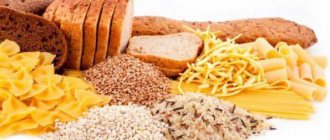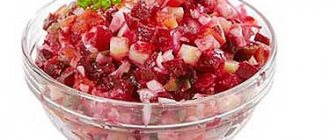What are fast carbohydrates
Fast carbohydrates are the simplest compounds. The body spends a minimum of energy on their processing. It is useful to consume such carbohydrates after training to restore strength and energy.
Fast carbohydrates are used to maintain vital functions. If a person moves little, they are not completely consumed and are sent to the subcutaneous tissue. If a person wants to lose weight, such carbohydrates are consumed in small quantities only to maintain strength and energy.
The difference between fast carbohydrates and slow ones is their rapid absorption and simple structure . Slow carbohydrates are more complex and are absorbed much more slowly by the body. They supply the body with energy for a long time and can give you a feeling of fullness for a long time.
Fast carbohydrates practically do not reduce appetite; after eating them, a person practically does not feel full. They supply the body with energy for a short period of time. You cannot completely abandon them, as they make a person energetic and full of strength. By giving up fast carbohydrates, a person will feel tired and performance will decrease.
Preparing cocktails for weight loss at home: popular recipes and reviews from those losing weight.
Find out from this article how to drink protein correctly for weight loss. Selection tips for women and men.
What are simple carbohydrates called?
Saccharides are divided into two groups - simple carbohydrates (also called monosaccharides) and slow carbohydrates (also called polysaccharides). They differ in that simple saccharides are converted into glucose much faster, while complex ones take longer to digest, maintaining a feeling of fullness. The most harmful are saccharides, which break down faster than others, leading to obesity. However, a lack of fast carbohydrates is also harmful: it leads to a lack of energy and strength.
Simple carbohydrates nourish the brain and help instantly restore strength. Consuming saccharides in normal amounts helps the brain work more actively. This name is given to simple sugars because they are quickly digestible and satiate well, as well as for their special structure.
Attention! Normal processing of proteins and fats does not occur in the body without these substances: simple saccharides are necessary for normal synthesis of substances. Without them, the liver cannot function normally.
There are different types of fast saccharides: fructose, glucose, mannose, galactose, etc. They consist of one molecule of structural monomers. There are also bimolecular carbohydrates: raffinose, lactose, maltose and sucrose. Sweets are especially important for those who exercise, as they increase insulin levels in the body and prevent muscle breakdown. It’s not without reason that light protein and sweets are added to gainers (cocktails that you drink after a workout). Sweets are also great for helping you gain weight, both with fat and muscle mass.
Video
The surge of insulin in the body enters the body's glycogen stores, fueling the muscles. If the body is losing strength, then fast carbohydrates will help stop nausea and dizziness. The best carbohydrates for instant recovery are chocolate, cookies, sweet fruits or baked goods. Every person needs such “reinforcement”, and every day. Energy and glycogen reserves in muscles are needed not only by athletes.
The relationship between carbohydrates and the glycemic index
The glycemic index is an indicator that determines the level of impact of foods on changes in blood glucose levels after consumption.
Carbohydrates and the glycemic index are indeed related. Experts distinguish carbohydrates with a high and low glycemic index:
- Low index carbohydrates do not cause a significant increase in glucose levels. These products include: lentils, beans. They do not significantly affect the figure and do not lead to weight gain.
- High index carbohydrates cause a significant increase in glucose levels. These products include: chocolate, sweets, baked goods, potatoes. May cause significant weight gain if consumed too frequently.
How many simple carbohydrates can you have per day?
There is no need to completely exclude fast carbohydrates from your diet. Saccharides make up a third of the total sugars consumed per day. The total mass of sugars is 2 grams per kilogram of body weight. Those who play sports, gain muscle mass, or do physical work should consume 3 to 4 g of saccharides per kilogram of body weight per day. If, for example, your weight is 65 kg, then the daily intake of simple and complex carbohydrates is 130 g, of which 43 g are fast carbohydrates.
Video
It is undesirable to consume more than the norm, as this leads to excess weight gain. However, it is also not worth removing fast carbohydrates from the diet, as this can cause indigestion or poor health and mood of a person.
Important! Excessive consumption of foods with high GI accelerates the development of atherosclerosis, diabetes, and is involved in the increase of bad cholesterol, obesity and caries.
Most nutritionists advise either completely avoiding saccharides or reducing their amount to a minimum. Nutritionists advise consuming more slow sugars – green vegetables and cereals. This is supposedly necessary so that the blood sugar level does not rise too sharply. This is not only ineffective in terms of weight loss, but also harmful to the body. Fast carbohydrates are especially important for those trying to build muscle mass. Lack of sugars leads to muscle breakdown and general lethargy. Remember that after training it is necessary to restore glucose reserves. Consume foods with a high GI content in moderation, and then you will not become overweight. When gaining muscle, it is best to calculate your norm and strictly follow it so as not to deprive your muscles of the nutrition they need. When losing weight, never neglect bananas or grapes, just eat these foods in moderation. It is best to eat sweet foods for the first or second breakfast. Remember that the glycemic index of a product may change when cooked. Thus, boiled carrots have a much higher glycemic index than raw carrots.
Are fast carbohydrates good for weight loss?
Many people who are losing weight diligently avoid fast carbohydrates during a diet, fearing for their figure. However, this is done in vain; in small quantities, these substances are very useful. Their benefits for weight loss are as follows:
- The body is saturated with energy, the person is cheerful, full of strength and energy.
- Stimulation of intestinal function. Fast carbohydrates normalize its functioning and there will be no constipation.
- No stress. If you give up this substance, a person will soon become nervous, irritable, and the diet will be very difficult to tolerate. With a small amount of fast carbohydrates, a person will be in an excellent mood and there will be no stress. The diet will be easy to follow.
- Removing harmful substances from the body. Fast carbohydrates can remove harmful substances from the body, which often accumulate on the walls of the digestive organs. Thanks to this property, a person’s well-being improves.
Benefits and harms
Let's look at how carbohydrates affect the body of a professional athlete:
| Benefit | Harm and contraindications |
| Quick replenishment of energy levels | Possible dependence on dopamine stimulation |
| Dopamine stimulation | Contraindicated for people with insufficient thyroid function. |
| Increased performance | Contraindicated for people who suffer from diabetes |
| Restoration of emotional background | Tendency to obesity |
| The ability to close the carbohydrate window with minimal losses | Short-term hypoxia of all tissues |
| Using blood sugar for physical activity | Excessive stress on liver cells |
| Stimulating brain function in the short term | Inability to maintain a calorie deficit |
| The ability to artificially create a microperiodization effect in appropriate nutrition plans | Artificial creation of a feeling of hunger due to the speed of the insulin reaction, and the subsequent optimization processes in the body |
As you can see from the table, there is as much harm from fast carbohydrates as from any other food. At the same time, the advantages of consuming fast carbohydrates for athletes almost completely outweigh their disadvantages.
What products contain
What are fast carbohydrates? They are contained in the following products:
- Bakery products.
- Sweet carbonated drinks.
- Sugar.
- Honey.
- Mayonnaise.
- Ketchup.
- Watermelon.
- Banana.
- Persimmon.
- Grape.
- Alcoholic drinks.
- Potato.
- Dates.
- Dried apricots.
- Mango.
- Sweet yogurt.
- Lentils.
- Beans.
- Carrot.
- Beet.
Minus 10 kg per week on a watermelon diet - is it possible? What are the benefits and harms of such a diet for the body?
You will find the correct recipe for celery soup for weight loss at the link.
What carbohydrates are healthy?
Healthy carbohydrates have a complex chemical structure that is difficult to digest under the influence of active digestive enzymes and hydrochloric acid. As a result, nutrients are absorbed slowly, but by 90-100%. For a long time, while food passes through the gastrointestinal tract, the body spends the resulting carbohydrates as energy for the functioning of internal organs and systems.
With the rapid absorption of simple carbohydrates, tissues cannot process the resulting saccharides, so excess nutrients begin to transform the liver into adipose tissue.
Cereals and legumes have a high content of complex carbohydrate chains. The body can obtain the maximum amount of vitamin and mineral compounds after digesting the germs and shells of grains. It is important to remember that under the influence of thermal and chemical treatment, 80% of the nutritional components are destroyed. Porridges should be steamed or cooked in water to reduce their calorie content.
High Carbohydrate Diet for Weight Loss
This weight loss technique is based on reducing the total calorie intake of the diet. To do this, you will need to exclude foods containing fast carbohydrates from the menu. They should be replaced with foods with complex carbohydrate chains. Therefore, your list of foods for weight loss should include foods rich in plant fiber. The dietary fiber found in fruits and vegetables causes a feeling of false satiety.
When it enters the stomach, fiber begins to swell, filling the free space. As a result, hunger is dulled, the daily amount of food consumed is reduced, as is the serving size. The chemical compound is practically not digested, so the body spends more energy on digestion than it receives from plant foods.
In addition to fresh vegetables and fruits, you should eat cereal porridges cooked in water. They have a similar effect, reducing appetite for 3-4 hours.
Diet to increase muscle mass
To gain lean muscle mass, you should follow a high-protein, low-carbohydrate diet. In order to obtain fructose and glucose, it is necessary to consume vegetables, fruits and leafy greens, with the exception of:
- bananas;
- grapes;
- potatoes;
- corn;
- various cereals
To prevent glucose from being converted into glycogen in the liver, you should drink up to 2 liters of liquid per day. It is allowed to consume freshly squeezed fruit, berry, and vegetable juices, herbal decoctions and still mineral water. Drinks will help remove excess fluid from the body and cause the breakdown of fat masses.
Table of foods with fast carbohydrates
Content of fast carbohydrates in food:
| The product's name | Carbohydrate content per 100 g of product |
| White bread | 53 |
| Bakery | 70 |
| Dates | 72 |
| Potato | 27 |
| Sweet drinks | 12 |
| Honey | 80 |
| Dried apricots | 65 |
| Grape | 15 |
| Bananas | 23 |
| Sweet yogurt | 10 |
| Mango | 12 |
| Watermelon | 8 |
| Sugar | 99 |
| Carrot | 5 |
| Beet | 6,5 |
| Chocolate | 80 |
| Ice cream | 23 |
| Beans | 8,7 |
Types of carbohydrates
People forget what carbohydrates are. Organic compounds are divided into 2 groups: with a simple and complex structure. Carbohydrates include saccharides, which are converted into energy or stored as adipose tissue. To protect the body from negative consequences, you should find out which foods contain carbohydrates and which type is more beneficial for the body.
Simple (fast) carbohydrates
Light carbohydrates are absorbed in the body within 15-20 minutes due to their simple chemical structure. The high rate of absorption of organic substances leads to a sharp increase in the plasma concentration of glucose in the blood. To normalize sugar levels, beta cells of the pancreas release large amounts of insulin into the blood. Excess glucose is converted into fat in a molecular ratio of 1:2.
The hormone reduces glucose concentrations to normal levels, so the person begins to feel a repeated attack of hunger. The amount of food and calorie intake increases, which leads to excess weight. If you continue to consume simple carbohydrates, the following side effects may develop:
- constant feeling of hunger;
- load and exhaustion of the pancreas;
- insulin damages the walls of blood vessels;
- increased risk of diabetes.
Complex (slow) carbohydrates
The complex structure of organic compounds is characteristic of plant fiber, animal glycogen, polysaccharides or starch. These substances are more difficult to break down into microelements and convert into energy, so their digestion takes up to 4-6 hours, depending on the metabolic rate and the functioning of the digestive organs.
During this time, the body completely absorbs glucose, transforming it into energy for tissues. At the same time, serum sugar levels do not increase, remaining within normal limits.
In addition, slow carbohydrates have a high energy value, so a person does not feel an increase in appetite. Due to the absence of excess sugar, glycogen is not formed in the liver.
What foods contain complex carbohydrates? Table
The content of carbohydrates with a complex chemical structure is observed in the following products:
- flour products made from wholemeal flour;
- mushrooms;
- unsweetened fruits;
- vegetables;
- cereals, beans;
- leafy greens.
Complex carbohydrates, the table of which contains mainly products of plant origin, allow you to get rid of the feeling of hunger for a long time.
| Products | Amount of carbohydrates per 100 g of product, g |
| Legumes: beans, beans, lentils | 53-55 |
| bitter chocolate | 48 |
| Whole wheat bread | 46 |
| Soybeans | 27 |
| Wheat flour pasta | 23 |
| Cashew | 22 |
| Canned peas | 13 |
| Olives | 12 |
| Pomegranate, sweet and sour apples, celery root, pear | 11 |
| Peach, fresh prunes, gooseberries | 10 |
| Onion, raspberry | 9 |
| Citrus fruits excluding grapefruit and lemon, currants | 8 |
| Kiwi, grapefruit, nuts except cashews | 7-11 |
| Zucchini | 6 |
| White cabbage, cauliflower and Brussels sprouts, broccoli, sorrel leaves, bell pepper | around 5 |
| Radishes, green onions, green beans | 4 |
| Lemon | 3,6 |
| Tomatoes | 3 |
| Cucumber, spinach, leafy greens | 2 |
| Mushrooms | 1-4 |
| Champignon | 0,6 |
The norm of fast carbohydrates, and the dangers of their excess
The norm is to consume 40 g of fast carbohydrates per day . An excess of this substance has a negative impact on human health:
- Body weight increases.
- Metabolism is disrupted.
- Changes in blood pressure occur: it may suddenly increase or decrease.
- Dermatitis, swelling, and cellulite occur.
- Diseases of the gastrointestinal tract develop.
- The likelihood of developing caries increases.
It is important to consume these carbohydrates within normal limits to avoid the development of diseases.
Recommendations from nutritionists
During carbohydrate starvation, the production of prolactin and cortisol increases, and the function of the thyroid gland decreases. This leads to bad mood, chronic fatigue, swelling, and the digestive system suffers. But doctors also do not recommend getting too carried away with such food; this can lead to obesity and other negative consequences.
At each meal, half the plate should be occupied by a vegetable salad, 1/4 each by carbohydrates and proteins, and a tablespoon of any vegetable oil - olive, flaxseed or sunflower.
A healthy lifestyle includes not only giving up bad habits, but also playing sports and eating a balanced diet. To do this, the diet must be varied and include all the necessary components. In this case, excellent health and an excellent figure are guaranteed.
If you find a typo or inaccuracy, please select a piece of text and press Ctrl Enter.
Useful tips from nutritionists
It is recommended to listen to nutritionists and follow their advice:
- Fast carbohydrates are consumed only within normal limits, not exceeding the recommended level.
- These substances are consumed in the first half of the day, for breakfast, to supply the body with energy.
- It is recommended to consume fast carbohydrates in the form of dried fruits, fruits and vegetables during the diet. Sweets are consumed less frequently and in small quantities.
- Eating such carbohydrates at night is strictly prohibited. Their consumption in the evening can lead to weight gain, since in the second half of the day a person moves less and does not need as much energy as in the first half of the day.
List of foods containing fast carbohydrates with an average glycemic index (55-70 units)
Good or slow carbohydrates are foods with a low glycemic index. Characteristics of this energy group:
- presence of vitamins, fiber and minerals
- chemical structure that speeds up metabolism
- prolonged digestion
- slow release of calories
The good ones, also known as complex compounds, are found in whole grains, unprocessed rice, cereals, nuts, seeds, vegetables and fruits.
The term “glycemic index” has entered the medical lexicon since 1981. Research has shown that the slow process has advantages:
- allows you to stay full longer;
- creates conditions for better digestion of food;
- accumulates vital energy.
For any activity, mental or physical, people need energy. The easiest way for the body to extract it is from carbohydrates supplied with food. To obtain guidelines for assessing the speed of assimilation, we calculated a scale from zero to one hundred. This indicator is called the glycemic index - GI.
Carbohydrates with a GI of more than 70 are considered fast. Carbohydrates with a GI of less than 40 are considered slow. As an analysis of metabolic characteristics has shown, they are all important for health, but their roles differ. To properly organize your diet, you need to know which foods contain slow carbohydrates and increase their amount in your diet.
Many nutritionists do not like to use the adjectives “harmful” and “healthy” in relation to types of food. They note that there are no harmful or healthy foods, but only poorly or well-chosen diets. Typically, carbohydrate compounds that contribute to a rapid increase in sugar are considered fast (that is, harmful).
The glycemic index was developed as a measure of the rate at which these compounds are converted into glucose. The index ranges from 0 to 100. The higher the glycemic index, the faster foods are digested and increase sugar levels. Ensuring a smooth increase in sugar levels is important to minimize spikes in insulin levels, as they can lead to excessive development of hunger and interfere with the fight against obesity.
Although the glycemic index is useful for diet planning, it is not perfect. For example, some types of ice cream and pasta may have low glycemic index values (about 30), but both contain a lot of calories with a minimum of nutrients. A number of foods with a high glycemic index (for example, watermelon) are characterized by a high GI, but they rarely lead to a significant increase in sugar levels, that is, they have a low glycemic load. When combining fast carbohydrate compounds with fats, their digestion slows down, and the risk of increasing sugar levels is reduced.
Despite all the apparent complexity, the situation is not so confusing. If you eat whole, natural, and unprocessed carbohydrates, you can usually consider them healthy. An exception may be some particularly sweet types of natural products (honey, sweet berries and fruits in large quantities, etc.).
The experience of eating slow and fast carbohydrates varies significantly. Try observing how you feel after eating foods rich in these compounds. If within half an hour you feel a surge of energy, then these were fast (simple) carbohydrates. It is important to understand that this sensation often passes with unpleasant consequences caused by a surge in insulin levels.
If after eating you did not experience a sharp surge of energy, but the feeling of hunger does not return for a long time after such a meal, then you consumed slow carbohydrates. They allow you to provide the body with energy for a longer period, although the fast type of connections is sometimes useful for giving strength to the body in case of overload and the need for quick mobilization.
What are slow carbohydrates? Widespread sources of slow carbohydrates are many familiar foods.
Dairy
- Low fat yogurt.
- Skimmed milk.
Nuts and legumes
- Almond.
- Peanut.
- Pumpkin seeds.
- Sunflower seeds.
- Walnuts.
- Lentils.
- Regular beans.
- Chickpeas
- Split peas.
- Soya beans.
- Soy milk.
Bread and cereals
- Bread varieties made from whole grains.
- Pasta varieties made from whole grains.
- Buckwheat.
- Brown rice.
- Barley and products made from it (for example, barley groats).
- Oats and oat products (for example, oatmeal).
- Sorghum.
- Quinoa.
- Corn.
Fruits and vegetables
It is important to understand that the sweeter a vegetable (for example, tomatoes, beets), fruit or berry tastes, the more fast carbohydrates it contains in addition to slow ones. Products containing slow carbohydrates may also contain significant amounts of fast carbohydrates.
- Potatoes (this product should be consumed with caution, as it can contribute to obesity due to its high starch content).
- Tomatoes.
- Onion.
- Carrot.
- Radish.
- Beet.
- Zucchini.
- Spinach.
- Apples.
- Pears.
- Plums.
The glycemic index shows how quickly the body absorbs the carbohydrates eaten and enters the bloodstream. The higher it is, the faster this process goes and the more actively a person gains weight. The GI also measures how quickly a food can raise blood glucose levels. Glucose with an index of 100 units is taken as the GI standard.
– high GI – more than 70;
– average GI – in the range from 50 to 70;
– low GI – less than 50.
The lower the GI, the more beneficial the product is for the health of the body.
Having a high glycemic index, fast carbohydrates can have a detrimental effect on human health. They do not provide the body with nutrients, and they dull hunger only for a short time. If sugar that enters the bloodstream is not converted into glycogen due to physical activity, it will be stored in the body as fat.
Therefore, all healthy nutrition systems recommend limiting the consumption of foods containing fast carbohydrates. You should be especially wary of fast carbohydrates in the afternoon; it is at this time that they pose the greatest danger to weight and figure.
A low glycemic index, on the contrary, promotes weight loss. If your goal is to lose weight, you can lose weight with a diet in which foods have a GI that does not exceed 55 units. In this case, a fit figure and a great mood are guaranteed.
When you eat foods containing fast carbohydrates, your blood sugar levels jump sharply. This is a negative factor for health and, according to doctors, can lead to the development of diabetes.
These products include:
- bread and other baked goods made from rye flour (coarsely ground);
- boiled carrots, peas, beets;
- kiwi, banana, apricot, pineapple, and melon;
- honey;
- pearl barley, oatmeal, buckwheat, rice, semolina and other cereals;
- corn, including popcorn;
- potatoes boiled in their jackets.
These products can be consumed in the first half of the day without fear of negative consequences, but only if the goal is not to lose a lot of weight.
The following foods, according to doctors, do more harm than good and interfere with the normal functioning of the body:
- sweet juices and cola (75);
- any baked goods made from wheat flour, puff pastry or yeast dough, for example, morning toast for breakfast, has a GI of 100 units;
- fried potatoes or fries (95) and mashed potatoes (90);
- bars (Snickers, Kit-Kat, Mars) and chocolates (70);
- watermelon (103);
- dates (146);
- sugar and milk chocolate (70);
- muesli with sugar and corn flakes (80-90);
- dried fruits and grapes (75);
- chips (85);
- alcohol and beer 3.0% (115);
- corn syrup (115);
- baked goods, cakes, pastries and fast food (103);
- Coca-Cola and carbonated drinks (102);
- parsnip (97);
- rice noodles (95);
- canned apricots and peaches (91);
- polished rice (90);
- honey (90);
- soft wheat pasta (90);
- hamburger bun (88);
- salty crackers (80);
- muesli with nuts and raisins (80);
- condensed milk (80);
- polished rice (80);
- beans (80);
- candy cane (80);
- semolina (75);
- cream cake (75);
- squash caviar (75);
- crackers (74);
- millet and millet groats (71);
- compotes (70);
- brown sugar (cane) (70);
- corn flour and grits (70);
- milk chocolate, marmalade, marshmallows (70);
- ice cream (70);
- glazed curd cheese (70).
The glycemic index of the product is given in parentheses.
It is best to keep this list for yourself and take into account the GI when preparing food dishes.
3 dinners for two with free delivery for RUB 1,690.
The concept of “glycemic index” (GI) is directly related to the value of blood sugar levels. The GI value shows how quickly the carbohydrates eaten are absorbed and enter the bloodstream. The higher the GI, the faster the carbohydrates and the more actively a person gets fat! The calculation is based on a standard of 100 units - glucose. But dates have amazing indicators above this “ideal of harmfulness” (146 units).
GI happens:
- high: {amp}gt;70
- average: 55-70
- low: {amp}lt;55
As you may have guessed, carbohydrates with a low GI are called slow, and those with a high GI are called fast.
Slow carbohydrates during pregnancy
Complex saccharides perform the following functions:
- are an excellent source of energy;
- improve digestion and metabolic processes;
- normalize glucose levels;
- maintains normal weight;
- fight depression;
- have a beneficial effect on the condition of the skin and hair.
Their deficiency leads to a decrease in mental abilities, deterioration of concentration, problems with sleep, and negatively affects the condition of muscle tissue.
It is necessary to maintain the required amount of polysaccharides during pregnancy, as they normalize the functioning of the pancreas. It is especially important for women with endocrine system disorders, where there are problems with insulin production. Improves peristalsis and fights constipation.
| First day | Oat flakes without sugar and oil; yogurt; Steamed chicken cutlet, cucumber; Stew - zucchini, tomatoes, onions, sweet peppers; Vegetable salad; Kefir, apple. |
| Second day | Steam omelette, tea; Cheese, a piece of bread, a chicory drink; Steamed fish, stewed vegetables; Curdled milk, plums; Mushrooms with herbs; Boiled rice, salad. |
| The third day | Coffee, low-fat cottage cheese; Cheese, bread, pear; Boiled veal, vegetables; Stewed beans with herbs, herbal infusion; Kefir with crackers, banana; Boiled lentils, fruit drink. |
| Fourth day | Tea, boiled egg, bread; Yogurt, banana; Mushroom soup, bread, salad; Baked fish, tomatoes, a portion of brown rice, compote without sugar; Kefir, boiled breast, tomato. |
| Fifth day | Coffee with milk, buckwheat porridge; Curdled milk, bread; Green cabbage soup, bread, banana; Boiled fish with vegetables, juice; Mushrooms with buckwheat, herbal tea; Vegetable salad, matsoni, berries |
- Low-fat fish and seafood.
- Poultry, rabbit, veal, beef,
- Brown rice, pearl barley and buckwheat, oatmeal, millet;
- Cucumbers, tomatoes, all types of cabbage, zucchini, eggplants, onions, radishes, green peas; beans, lentils, peas, chickpeas; mushrooms;
- Greens - parsley, cilantro, tarragon, dill, basil;
- Fruits and berries - currants, apples, pears, watermelons, plums, citrus fruits, kiwi, cherries and others; dried fruits.











